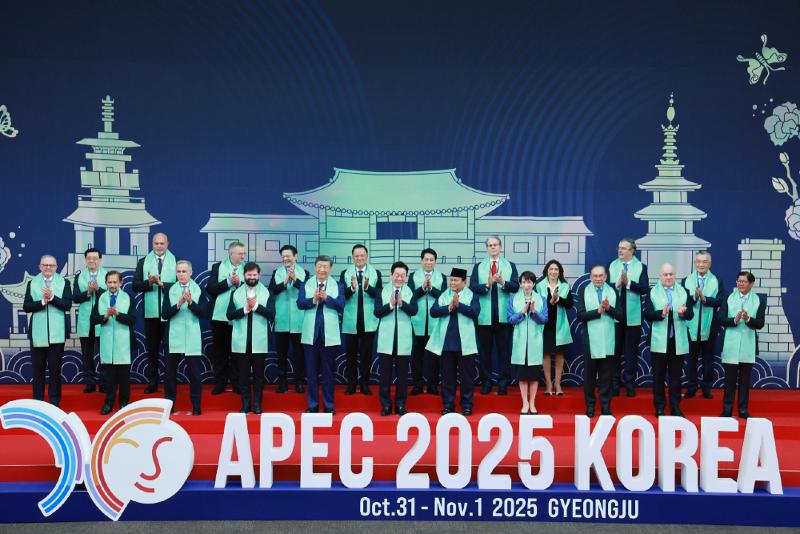
President Lee Jae Myung (sixth from left in front row) on Nov. 1 poses for a group photo of heads of state attending the Asia-Pacific Economic Cooperation Economic Leaders' Meeting at Gyeongju Hwabaek International Convention Center in Gyeongju, Gyeongsangbuk-do Province. (Yonhap News)
By Yoon Sojung
This year's APEC (Asia-Pacific Economic Cooperation) Economic Leaders' Meeting concluded on Nov. 1 with the adoption of the Gyeongju Declaration, which represents the solidarity and cooperation of APEC member states.
World leaders attending the two-day gathering in Gyeongju, Gyeongsangbuk-do Province, that day adopted three documents -- the declaration, APEC AI (Artificial Intelligence) Initiative and APEC Collaborative Framework for Demographic Changes -- at the retreat session chaired by President Lee Jae Myung.
Based on the three key tasks of this year's APEC -- connect, innovate and prosper -- the declaration expresses the need for cooperation in trade and investment; digital transformation and innovation; and growth for all. It also highlighted the development of innovative technologies such as AI and demographic changes marked by low birth rates and an aging society as major changes, stressing the need for joint responses and collaboration among member states for economic growth.
"It reflects APEC's mid- to long-term vision for an open, dynamic and peaceful Asia-Pacific community and the commitment of member states to achieve the Putrajaya Vision 2040," President Lee that day told a news conference on the declaration. "It also includes the intent of member countries to cooperate for the recovery and growth of the Asia-Pacific region."
The declaration is the first joint document of APEC leaders to explicitly mention the cultural and creative industries (CCI), while also recognizing CCI as a new growth engine in the region and emphasizing the need for cooperation in that regard.
Leaders of APEC member countries also adopted the AI initiative, APEC's first codified joint vision among members on AI and the first summit-level agreement on the sector having the participation of the U.S. and China, and the framework for demographic changes.
The initiative reflected the government's basic policies and practical cooperation in AI including the goals of an AI-based society and an Asia-Pacific AI center.
As APEC's first comprehensive initiative for cooperation in population issues, the framework was based on the recognition that demographic changes such as low birth rates and an aging society are challenges common to the region.
arete@korea.kr